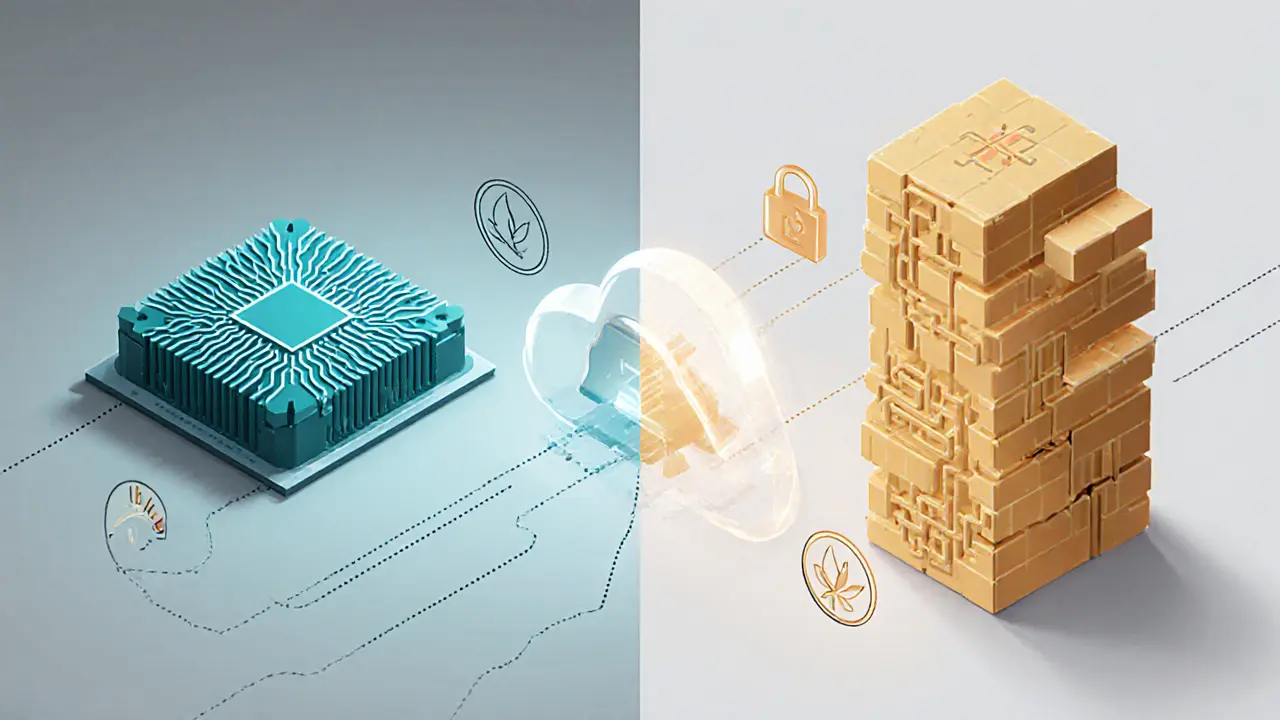Key Challenges of AI-Blockchain Integration in 2025

AI-Blockchain Integration Readiness Checker
Evaluate your AI-blockchain project against critical integration challenges to determine feasibility and identify potential roadblocks.
Overall Score: 0%
TL;DR
- Scalability limits blockchains to tens of transactions per second, far below AI's data‑ hungry needs.
- On‑chain storage of large AI datasets is prohibitively expensive and immutable.
- Privacy rules like GDPR clash with blockchain’s transparent ledger.
- Lack of common standards forces developers to build custom bridges for each project.
- Energy‑intensive proof‑of‑work and AI training make combined systems environmentally unsustainable.
When AI‑blockchain integration is the merging of artificial intelligence (AI) capabilities with decentralized ledger technology (blockchain), the promise is huge: smarter contracts, tamper‑proof data, and automated trust‑less services. Yet the reality feels more like juggling two heavyweight engines that were built for different tracks. Below we unpack the technical, regulatory, and talent‑driven obstacles that keep this hybrid dream in its early stages.
Scalability and Throughput Mismatch
At its core, Blockchain a distributed ledger that records transactions across a peer‑to‑peer network relies on consensus. Bitcoin squeezes about 7 transactions per second (TPS) and Ethereum, even after the merge, hovers around 15‑30 TPS. AI models, especially deep‑learning pipelines, need to move gigabytes of data in milliseconds. The gap is akin to trying to stream 4K video over a dial‑up connection.
Developers therefore adopt Layer‑2 scaling solutions like rollups, sidechains, and state channels that process transactions off the main chain. While rollups can boost throughput to thousands of TPS, they add latency when data must be committed back to the base layer, hurting real‑time AI inference.
Hybrid architectures usually push heavy lifting-training, large‑scale inference-to powerful off‑chain GPUs, then write only the verification hashes or outcomes on‑chain. This split reduces on‑chain load but creates a new coordination problem: ensuring the off‑chain computation is trustworthy without compromising speed.
Data Storage Costs and Immutability
Storing even a modest 1GB of data on Ethereum a programmable blockchain that supports smart contracts can cost thousands of dollars in gas fees. AI training sets often exceed terabytes, making raw on‑chain storage financially impossible.
Beyond cost, blockchain’s immutable ledger means you cannot simply delete or correct a flawed dataset. If an AI model learns from erroneous or biased data, the mistake is baked into the chain. Developers resort to pointer‑based designs: store the data off‑chain (IPFS, cloud buckets) and embed a content‑addressed hash on the blockchain. This preserves proof of existence while allowing updates, but it also weakens the guarantee of a single source of truth.
Privacy, Security, and Regulatory Tensions
Personal data on a public ledger is a red flag for regulators. The GDPR European data‑protection law that requires the right to be forgotten explicitly conflicts with blockchain’s permanence. Even if data is anonymized, AI can re‑identify individuals by correlating multiple data points, creating a compliance nightmare.
Smart contracts-self‑executing code stored on‑chain-are another privacy pain point. When they trigger actions based on AI‑derived insights, the underlying logic often needs access to sensitive inputs. Encrypting these inputs end‑to‑end is possible, but performance drops dramatically, especially on proof‑of‑work chains.
Speaking of proof‑of‑work, the Proof‑of‑Work consensus mechanism used by Bitcoin that requires solving computational puzzles consumes massive energy. Adding AI model training on top of that pushes the carbon footprint beyond what most organizations consider sustainable.

Interoperability and Standardization Gaps
AI frameworks (TensorFlow, PyTorch) speak a different language than blockchain virtual machines (EVM, WASM). There is no universal protocol for moving model weights, inference results, or training metrics across chains. Each project ends up building custom adapters, which hampers portability and raises security risks.
Emerging standards like the Ontology for AI‑Blockchain Interoperability (OABI) propose a common schema for data‑format exchange, but adoption remains fragmented. Until a widely accepted set of APIs and data models materializes, developers will continue to DIY, inflating costs and time‑to‑market.
Talent Shortage and Development Complexity
Finding engineers fluent in both machine learning and cryptographic consensus is rare. Most teams consist of a blockchain specialist paired with a data‑science lead, leading to communication gaps and duplicated effort. The skill mismatch drives up salaries and extends project timelines, making many pilots abandon the integration dream altogether.
Energy Consumption and Environmental Impact
AI training already accounts for a sizable share of global electricity use. Couple that with a proof‑of‑work blockchain, and the combined system can double or triple the energy draw. Some enterprises mitigate this by migrating to proof‑of‑stake chains, where validator nodes replace miners, cutting energy use by up to 99%.
However, proof‑of‑stake introduces its own trade‑offs-centralization risk and novel attack vectors-that must be weighed against the sustainability gains.
Emerging Hybrid Solutions and Best‑Practice Checklist
Despite the hurdles, several patterns are gaining traction:
- Off‑chain AI services with on‑chain verification: Run models on cloud GPUs, then publish a cryptographic proof (e.g., zk‑SNARK) to the blockchain.
- Use Sharding splitting a blockchain into multiple parallel pieces to increase throughput for data‑intensive AI logs, reducing bottlenecks.
- Adopt Off‑chain computation frameworks like Truebit that let heavy calculations happen off the main chain while preserving trust through dispute resolution.
- Leverage privacy‑preserving techniques such as homomorphic encryption or secure multi‑party computation when feeding personal data into AI pipelines.
- Choose proof‑of‑stake or delegated proof‑of‑stake networks to cut energy use without sacrificing security.
Below is a quick checklist to evaluate any AI‑blockchain project before you commit resources:
| Domain | Key Question | Typical Answer |
|---|---|---|
| Scalability | Can the blockchain handle the required TPS? | Use Layer‑2 or proof‑of‑stake alternatives. |
| Data Cost | Is on‑chain storage affordable for the dataset? | Store off‑chain, keep only hashes on‑chain. |
| Privacy | Does the solution meet GDPR/CCPA? | Apply encryption and zero‑knowledge proofs. |
| Interoperability | Are standard APIs available? | Prefer platforms that support OABI or similar. |
| Talent | Do you have hybrid AI‑blockchain expertise? | Partner with specialized consultancies. |
| Energy | Is the energy profile sustainable? | Choose proof‑of‑stake, off‑load AI to green clouds. |
By ticking off each line, you’ll quickly see whether the project is technically viable, legally safe, and financially sane.
Frequently Asked Questions
Why can’t I store AI training data directly on a blockchain?
On‑chain storage is extremely costly and immutable. A single gigabyte can cost thousands of dollars in gas, and once written the data cannot be edited, which conflicts with the need to clean or update training sets.
What is a zero‑knowledge proof and how does it help?
A zero‑knowledge proof lets you prove that a computation (like an AI inference) was performed correctly without revealing the underlying data. Posting the proof on‑chain gives trust while keeping inputs private.
Which blockchain platforms are most AI‑friendly today?
Platforms that support smart contracts and have robust Layer‑2 ecosystems-such as Ethereum (with rollups), Polygon, and Solana-are commonly used. Some projects also explore specialized chains like Fetch.ai that embed AI primitives.
Is proof‑of‑stake enough to solve the energy problem?
Proof‑of‑stake reduces the blockchain’s own energy use dramatically, but AI training still consumes power. The overall footprint depends on the source of AI compute-green cloud providers paired with PoS chains give the best sustainability profile.
What skills should my team develop to tackle AI‑blockchain projects?
A blend of machine‑learning engineering, cryptography, smart‑contract development, and knowledge of data‑privacy regulations. Cross‑training and hiring hybrid talent or external consultants can bridge the gap.


karsten wall
February 20, 2025 AT 11:55When you slice the AI‑blockchain stack, the scalability bottleneck surfaces as a classic throughput‑latency trade‑off; the ledger’s consensus latency dwarfs GPU inference cycles, so any sane architecture offloads heavy tensor ops off‑chain and anchors results with a cryptographic proof. Leveraging rollups or zk‑SNARKs restores determinism while preserving decentralised auditability, albeit at the cost of added proof verification overhead.
Keith Cotterill
February 21, 2025 AT 04:35Honestly, the entire hype train is nothing but a misguided fetish for decentralisation-everywhere you look, developers cram massive neural nets onto brittle ledgers, ignoring the elementary principle that data‑throughput must dominate compute‑throughput; otherwise you end up with a glorified spreadsheet, not a real AI‑powered ecosystem.
C Brown
February 21, 2025 AT 21:15Yeah, sure, let's just trust a hash on a chain and call it "AI". Meanwhile, real‑world users are left waiting for confirmations that take longer than a coffee break, making any supposed "smart contract" feel about as intelligent as a stone.
mukund gakhreja
February 22, 2025 AT 13:55Actually, the split‑compute model you dismiss does solve the cost issue-store only the model hash on‑chain, keep the meat off‑chain, and you get verifiable provenance without burning through gas. It's not a fetish, it's pragmatic engineering.
Darrin Budzak
February 23, 2025 AT 06:35I see the point about off‑chain computation; just make sure the verification step is lightweight enough not to become the new bottleneck.
Latoya Jackman
February 23, 2025 AT 23:15Privacy concerns dominate the conversation because blockchain’s immutable ledger runs head‑first into regulations like GDPR and CCPA, which demand the right to be forgotten. When a hash points to data that cannot be erased, auditors raise red flags. One practical workaround is to store raw personal data off‑chain and only keep a salted hash on‑chain, allowing the off‑chain store to comply with deletion requests. However, this approach does not eliminate the risk of re‑identification through correlation attacks, especially when AI models can infer identities from aggregated outputs. Zero‑knowledge proofs offer a promising avenue: they let you prove that a computation was performed correctly without revealing the underlying inputs. Deploying zk‑SNARKs on a proof‑of‑stake chain can keep verification costs low while preserving privacy. Energy consumption is another critical factor; proof‑of‑work chains like Bitcoin consume megawatts, and coupling them with GPU‑intensive AI training would be environmentally reckless. Switching to proof‑of‑stake or using green cloud providers dramatically cuts the carbon footprint. Interoperability remains a thorny issue; the majority of AI frameworks output tensors in formats that blockchain virtual machines cannot parse directly. Middleware such as Truebit or custom adapters can bridge this gap, but they add latency and surface new attack vectors. Talent scarcity cannot be ignored-finding engineers fluent in both deep‑learning pipelines and cryptographic consensus is akin to hunting unicorns. Companies often resort to consultants, inflating budgets and extending timelines. Despite these hurdles, several pilot projects demonstrate feasibility by using off‑chain inference services that post signed results to the chain. In practice, a modest architecture might involve an on‑chain oracle that fetches a signed hash of the inference result, then a smart contract that validates the signature before proceeding. This pattern balances trust, cost, and performance. Finally, regulatory sandboxes in jurisdictions like the EU and Singapore provide a safe space to experiment with AI‑blockchain combos without incurring full compliance penalties, allowing innovators to iterate quickly. Altogether, the landscape is challenging but not impassable; success hinges on thoughtful partitioning of workloads, rigorous privacy engineering, and judicious choice of consensus mechanisms.
CJ Williams
February 24, 2025 AT 15:55Great points! 👍👍 Off‑chain heavy lifting + on‑chain immutability is the sweet spot 🚀; just remember to keep gas fees in check, and sprinkle some zk‑proofs for privacy 🔐.
dennis shiner
February 25, 2025 AT 08:35Zero‑knowledge proofs solve the privacy‑throughput dilemma.
Mangal Chauhan
February 26, 2025 AT 01:15Dear colleagues, it is incumbent upon us to adopt a layered architecture wherein computationally intensive AI workloads are executed in secure enclave environments, whilst the blockchain layer is reserved exclusively for anchoring deterministic outcomes via succinct cryptographic attestations.
Darius Needham
February 26, 2025 AT 17:55From a cultural standpoint, integrating AI with blockchain can democratise access to trustworthy data, provided that local data‑sovereignty laws are respected and community governance models are inclusive.
Narender Kumar
February 27, 2025 AT 10:35Behold the grand tapestry of technological ambition, where silicon mind meets ledger stone, and yet the chorus of scalability sings a mournful lament.
Anurag Sinha
February 28, 2025 AT 03:15Did you know the 5G rollout is secretly a front for embedding hidden AI modules into every blockchain node, allowing elite cabals to monitor every transaction in real time? It's all in the firmware.
Raj Dixit
February 28, 2025 AT 19:55Honestly, the only thing worse than a useless blockchain is a dumb AI that thinks it can fix it.
Andrew McDonald
March 1, 2025 AT 12:35While your enthusiasm is noted, the idea that any AI can operate securely on a public ledger without rigorous audit trails borders on negligence; a proper risk assessment would reveal multiple attack surfaces.
karyn brown
March 2, 2025 AT 05:15🔥🔥 The hype train is leaving the station, but remember: if your crypto‑AI combo can’t handle privacy, it’s just 🔥 and smoke.
Sabrina Qureshi
March 2, 2025 AT 21:55Wow-this whole integration saga is just another drama, draining everyone's energy!!! 😭😭😭
Michael Ross
March 3, 2025 AT 14:35Balancing performance, cost, and compliance remains the core challenge for any AI‑blockchain deployment.